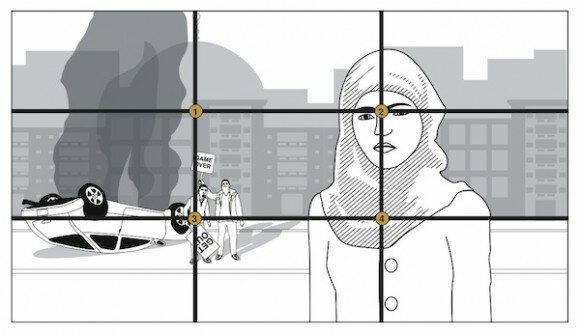
As part of our forthcoming multimedia storytelling app, we are working on simplifying video composition. One of the app’s primary features is to provide training to the users. Each user will be able to improve her multimedia production skills as she learns to use the app.
In order to ensure the app provides the greatest training impact possible, we have to work to ensure that it can teach users without the involvement of a human trainer. Small World News has generally made its mark by providing high quality multimedia and new media training to individuals in difficult to reach places. We recognize that in the future, if we are to expand, we have to create better tools for distance training, because we cannot be everywhere at once.
One of the most complex concepts to teach new students is composition, both what to put in the camera’s frame, and how to use different size frames to advance a story. Over the past week I’ve been reviewing dozens of random frames from a variety of movies and television shows.
I had a theory, going into the research, that there are clear rules that become clear after reviewing enough samples. Every first year film student learns about the basic shots: establishing shot, wide/long shot, medium shot, and close up. They also learn about the rule of thirds, a guide for using a grid pattern to help direct the framing of individual shots. The combination of standard shot sizes and a framework for composing the shots leads to a finite number of “standard shots.”
So far the research seems to back this theory. I have reviewed more than a dozen shots in each of 4 categories, chosen randomly via google images searches. I’ve found that there are slightly different guidelines for the size of the primary subject in each type of shot.
In an Establishing Shot, individual human subjects tend to fill less than 10% of the frame, and the foreground fills only the bottom third of the frame. The horizon and background fill at least the top two thirds.
In a Long Shot, human subjects fill between 15-20% more than 60% of the time. The total range tends to be between 15 and 30% of the total frame. The rest of the frame is filled by the immediate location where the scene takes place, and the horizon is often not visible.
In a Medium Shot, human subjects fill between 30% and 60% of the frame. The rest of the frame is filled with the area surrounding the subject, though specific details may not be distinguishable.
In a Close Up, human subjects fill between 40 and 70% of the frame. In a Close Up the subject’s location is indistinguishable.
As we get closer to finalizing the curriculum for the app, I’ll be researching additional rules and guidelines we can implement. I hope these revelations will assist other trainers, journalists, and citizen journalists to create more interesting compositions. Particularly for newcomers and amateurs to he medium, effective use of different types of shots can greatly increase the impact of still and video images.
Brian Conley
Blog, Featured, Small World News Blog